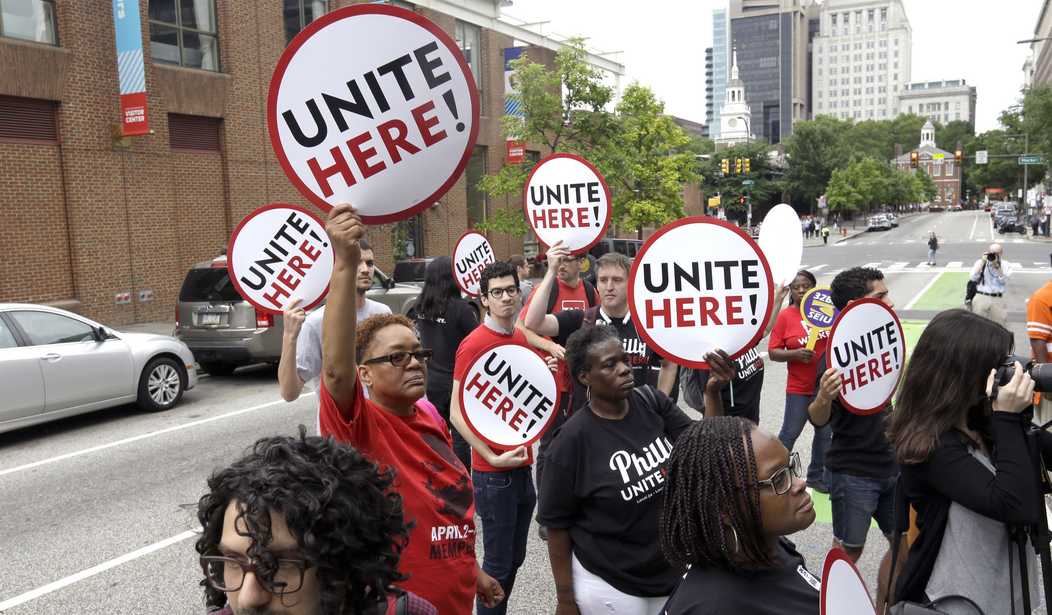Houston Texans quarterback C.J. Stroud recently observed, “Basketball players want to be football players, and football players want to be basketball players.” I think it’s equally true of union executives and lawmakers: Those running labor unions want to be politicians, and politicians want to run labor unions.
Any union member who has seen their elected union leadership go astray would know what I’m talking about. I first learned about union executives’ unhealthy interest in politics from a former local firefighter union president Frank Ricci, who saw it firsthand among state- and national-level union executives in Connecticut. He distinguished between advocating for workers (which he’s still doing) and enlisting oneself as a political operative in party politics. Good union leaders would draw the same line.
Unfortunately, union executives running the country’s largest public sector unions—including teacher unions like the American Federation of Teachers (AFT) and the National Education Association (NEA)—have trouble drawing that line. The allure of political celebrity often leads them to treat the union as their shot to elect politicians or advance political causes that have nothing to do with rank-and-file employees. Instead of boring themselves negotiating fair contracts and helping employees with workplace issues, union executives want the excitement and intrigue of political maneuvering, horse trading, and media appearances.
Many politicians—especially on the Left—seem more than willing to trade places. They, too, grow tired of the daily grind: Meeting with constituents and lobbyists, campaign fundraising, and attending legislative sessions weighed down by procedure and long-winded speeches can seem like a waste of time. They crave somewhere they can use more aggressive language, march in the streets, or even get arrested. They want to be on-the-ground advocates for workers.
Recommended
This attempted role reversal makes it increasingly difficult to tell the difference between politicians and government union executives. Without any real connection to rank-and-file employees, politicians claim they’re standing up for the “little guy.” Meanwhile, with no real policymaking experience, government union executives collect money and deploy ground troops for party politics.
The proof is in the numbers. In a groundbreaking new report, Andrew Holman, a policy analyst with the Commonwealth Foundation, and I track the national political spending of the country’s four largest public-sector unions: NEA; AFT; the American Federation of State, County, and Municipal Employees; and the Service Employees International Union. We concluded public sector unions have become cash cows to advance progressive politics, now more than ever.
Looking at campaign finance data and union reporting, we discovered these four unions spent $708.8 million on political activities during the 2021–22 election cycle alone. Moreover, most of this money—nearly 60 percent—came straight from membership dues, with the remaining political money stemming from more traditional union political action committees (PACs). Members may be unaware of their role in funding party politics, especially in states that automatically collect union dues from paychecks.
Union members may also be surprised that the unions’ political spending is heavily one-sided. Nearly 96 percent of union PAC spending went to support Democratic candidates and organizations for use in federal and state campaigns. Meanwhile, membership dues support a thriving ecosystem of progressive-oriented organizations, which is hardly reflective of the range of viewpoints represented within membership.
However, even workers ideologically aligned with union executives may resent their money going to political projects in other states. Nearly 60 percent of all state-level PAC spending went to five states: Illinois ($27.9 million), California ($24.9 million), Minnesota ($13.2 million), Pennsylvania ($12.1 million), and Washington ($7.5 million).
Combined, these four unions outspent entire industries at the federal level, surpassing even the defense sector. The only single entity to beat these unions’ collective effort was George Soros’s infamous Soros Fund Management.
Greater transparency would go a long way toward addressing the obscene spending undertaken by union executives running the country’s largest public sector unions. But we also must enact state-level reforms to refocus government union executives and force politicians to serve their constituency. If we’re going to have public-sector unions, they shouldn’t exist as a funding arm for a political party.
This way, politicians and union executives can focus on their day jobs.
David R. Osborne is the Senior Fellow of Labor Policy with the Commonwealth Foundation, Pennsylvania’s free-market think tank.

























Join the conversation as a VIP Member